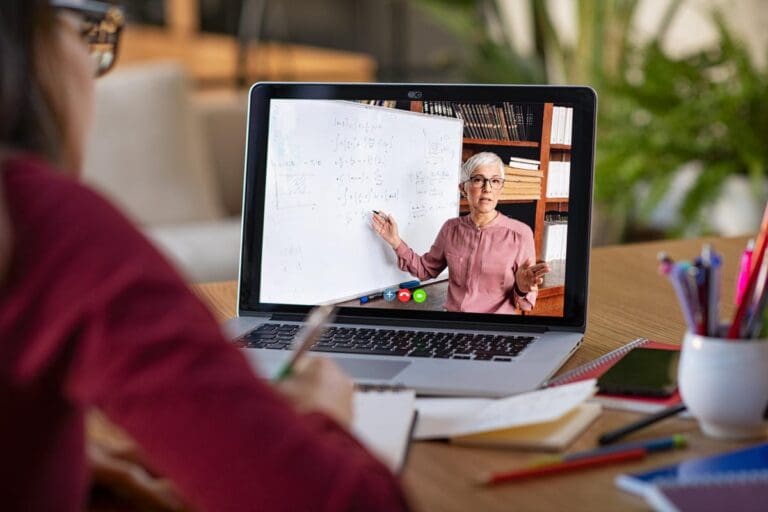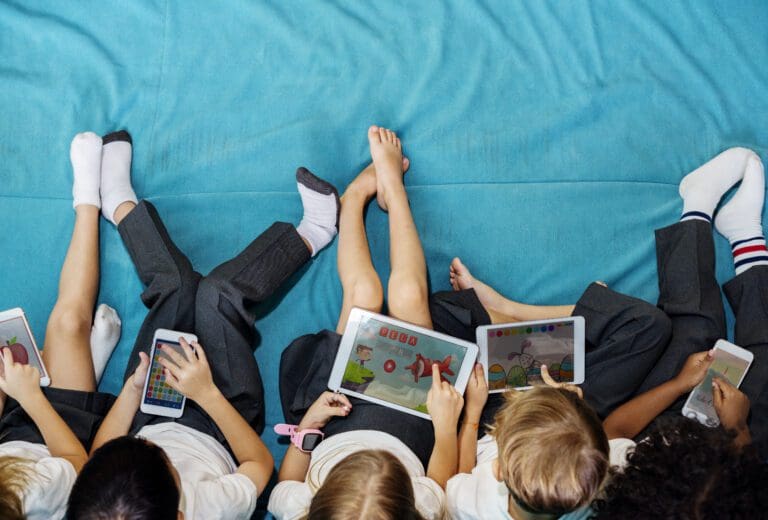Screen Time Guidelines: How To Find the Right Balance for Your Kid
In today’s world of technology, screens are everywhere, from televisions to tablets, and children are increasingly exposed to them at younger ages. While there are benefits to screen time, too much can negatively impact children’s health and development. Therefore, parents must establish screen time guidelines encouraging a healthy balance.
Understanding Screen Time
As parents, we should be mindful of how much our children spend in front of screens, such as televisions, computers, tablets, and smartphones. While some screen time can be beneficial, excessive use can adversely affect a child’s health and development.
TVs are a common source of screen time, but we should know the risks associated with too much TV. A sedentary lifestyle can lead to obesity, and watching TV before bed can impact sleep quality. Therefore, we should establish healthy screen time guidelines for our children from a young age.
Play helps children develop social, emotional, and cognitive skills essential for their growth. Encouraging our children to play outside, engage in imaginative play, and participate in non-screen activities is crucial for their development. It’s also vital for children to engage in unstructured playtime that does not involve screens.
Educational screen time can be valuable for our children’s learning and development. Educational apps, games, and videos can help our children develop new skills and improve their academic performance. However, we must monitor our children’s content and ensure it’s age-appropriate.
How many hours of screen time a day is healthy?
The Centers for Disease Control and Prevention (CDC) recommends screen time usage by age. Children aged 2 to 5 should not have more than one hour of screen time daily. For kids aged 6 and above, screen time for teens – it’s up to parents to determine how much screen time is reasonable. Parents should also prioritize educational screen time over entertainment.
Concerning TVs specifically, it’s crucial to set boundaries early on. Children under two years old should not have any screen time, and those between 2 and 5 should not watch more than an hour of TV daily. For children aged 6 and above, limiting their screen time to a maximum of two hours per day is best.
Additionally, parents should focus on educational screen time over entertainment options. Educational apps, games, and videos can help kids learn and develop new skills, but parents should ensure that the content is appropriate for their child’s age.
Parents should also lead by example when it comes to screen time. Since kids often model their behavior after their parents, it’s essential to establish healthy screen time habits for the entire family.
What is the recommended screen time by age?
Screen time guidelines are helpful for parents who want to promote healthy habits for their children. By setting limits, prioritizing educational screen time, and modeling good behavior, parents can help their children develop into well-rounded individuals.
| Age Group | Recommended per Day | Average Screen Time per Day |
| 0-2 years | No screen time recommended | 30 minutes |
| 2-5 years | 1 hour or less | 2-3 hours |
| 6-10 years | 1-2 hours | 4 hours |
| 11-13 years | 2 hours or less | 6 hours |
| 14-17 years | 2 hours or less | 7 hours |

The Impact of Screen Time on a Child’s Health
Excessive screen time, especially with TVs, can harm a child’s physical and mental well-being. A sedentary lifestyle caused by prolonged screen time can lead to a higher risk of obesity, cardiovascular disease, and other health problems. In addition, prolonged screen time can negatively affect a child’s mental health, leading to behavioral issues, difficulty concentrating, impulsivity, and decreased attention span. Furthermore, it can also impact a child’s sleep quality, affecting their overall health and quality of life.
As responsible parents, it’s essential to establish healthy screen time guidelines that promote our children’s physical and mental health. Encouraging children to engage in physical activities, such as playing outside or participating in sports, can help counteract the passive effects of screen time. Moreover, encouraging children to take regular breaks from screen time to rest their eyes and mind is also crucial. By participating in non-screen activities like reading, drawing, or playing board games, children can develop their creativity and imagination while giving their minds a break from screens.
How does screen time affect a child’s development?
When kids spend too much time looking at screens, it can be harmful to their growth in multiple ways, like their physical, social, and mental development.
Physically, excessive screen time can lead to them sitting around too much and not getting enough exercise. This can lead to obesity and other health problems. Additionally, a lack of physical activity can make it harder for kids to develop their motor skills as well as:
- Impacts on Attention: Research suggests that too much screen time can lead to decreased attention spans, making it harder for kids to focus and concentrate.
- Sleep Issues: The blue light emitted by screens can interfere with sleep, making it harder for kids to fall asleep and stay asleep.
Concerning social development, too much screen time can make it harder for kids to learn how to socialize properly and form meaningful connections with others. For instance, social media and online gaming can make kids feel like they’re connecting with people even though they’re not actually communicating in person.
Finally, screen time can have a negative impact on cognitive development as well. This includes attention span, memory, and language development. Kids who are exposed to screens too often may have difficulty being creative or solving problems.
To help kids grow up healthy and well-rounded, it’s important to limit their screen time and ensure they’re doing plenty of activities promoting physical activity, social interaction, and cognitive development. Parents should also be careful about the content their kids are seeing online and encourage healthy screen habits like taking breaks and avoiding screens before bedtime.
Screen Time Guidelines, Boundary Setting, and Educational Recommendations
Technology is everywhere today, and kids spend more time than ever in front of screens. Whether for fun, education, or communication, screens are becoming a big part of their lives. But too much screen time can negatively affect their physical, mental, and emotional health. Therefore, parents and caregivers must set boundaries and screen time guidelines for their children’s screen time usage.
Guidelines for Screen Time
The American Academy of Pediatrics (AAP) recommends that children aged 2 to 5 have no more than an hour of screen time per day. For children 6 and older, the AAP recommends setting consistent limits on screen time and ensuring that it doesn’t interfere with other important activities, such as sleep, exercise, and socializing:
- For children aged 2 to 5 years old, the AAP recommends no more than one hour of screen time per day: https://www.healthychildren.org/English/media/Pages/default.aspx#home-section
- For children aged 6 and older, the AAP recommends that parents set consistent limits on the amount of screen time and ensure that it doesn’t interfere with other important activities: https://www.healthychildren.org/English/media/Pages/default.aspx#home-section
- The AAP also provides additional resources for parents on how to manage screen time for children: https://www.healthychildren.org/English/media/Pages/default.aspx#home-section
Boundary Setting for Screen Time
Establishing boundaries around screen time can help ensure that children have a healthy balance between screens and other activities. Parents and caregivers can limit when and where screens can be used and how long. For example, screens can be prohibited during meals or before bedtime. Parents may also choose to restrict access to content or apps that are not age-appropriate or promote negative behaviors.
Educational Recommendations for Screen Time
While too much screen time can have adverse effects, technology can also be an excellent educational tool. Many educational programs and apps are designed to help children learn new skills and concepts in fun and engaging way. Parents can encourage the use of educational technology by seeking out high-quality, age-appropriate programs and using them in conjunction with other learning activities, such as reading and hands-on play.
Screen time is a reality of modern life, and parents and caregivers need to set guidelines and boundaries for their children’s screen time usage. Following the AAP screen time guidelines and setting consistent limits, parents can ensure their children strike a healthy balance between screens and other activities. Additionally, incorporating educational technology into children’s learning experiences can help them develop important skills while promoting healthy screen time habits.
The Role of Family in Managing Screen Time
As a parent, it’s essential to be aware of the impact that screens, such as TVs and social media, can have on our children’s lives. While some screen time can be beneficial, too much can negatively affect a child’s development and well-being.
One effective way for parents to help their children develop healthy screen time habits is by leading by example. This means setting aside time for non-screen activities, like playing games together as a family or going outside, and limiting the time spent in front of screens.
Parents must also stay informed about the content their children are accessing online, particularly on social media platforms. Monitoring their child’s social media use and having honest conversations about the potential risks and benefits can be helpful.
Moreover, parents can encourage their children to use screens in ways that promote learning and socialization. For example, parents can engage in educational activities with their children, such as watching programs or playing games together.
Lastly, family time can be an opportunity to share information about responsible screen use. Parents can discuss the importance of balancing screen time with other activities, setting limits on screen time, and practicing good digital citizenship.
In summary, the family plays a significant role in managing a child’s screen time. Parents can guide their children in developing healthy screen time habits by modeling good behavior, monitoring social media use, encouraging learning and socialization, and sharing information about responsible screen use.
Screen time and children: How to guide your child
As technology continues to dominate modern life, screens, including our children, have become a regular part of our daily routine. However, too much screen time can negatively affect their health and well-being, so parents need to guide their children on appropriate screen time usage. Here are some tips on how to guide your child:
- Set Clear Boundaries. It’s important to set clear boundaries around screen time to help your child understand how much time they are allowed to spend on screens each day. The American Academy of Pediatrics recommends that younger children should have no more than an hour of screen time per day. In comparison, older children should have consistent limits on their screen time to ensure it doesn’t interfere with other important activities such as physical activity, sleep, and socialization.
- Be a Good Role Model. Children learn by imitating their parents’ behavior, so it’s crucial to be a good role model when it comes to screen time usage. Limiting your screen time and showing an interest in other activities can encourage your child to do the same.
- Encourage Other Activities. Encouraging your child to participate in sports, arts and crafts, reading, and playing outdoors can help reduce their screen time. These activities can also promote physical, social, and cognitive development, which is essential for their well-being.
- Monitor content. As a parent, it’s important to monitor the content your child is exposed to on screens. You must ensure that the content is age-appropriate and free from violent or inappropriate material. You can also use screen time for educational purposes, such as playing educational games or watching educational videos.
- Use Technology to Your Advantage. Technology can be used to your advantage when it comes to monitoring your child’s screen time. Many devices come with built-in parental controls that allow you to set limits on screen time, block certain content, and monitor your child’s usage.
Screen time is a part of modern childhood, but it’s crucial to guide your child on appropriate usage. Setting clear boundaries, being a good role model, encouraging other activities, monitoring content, and using technology to your advantage can help ensure that your child has a healthy balance between screen time and other activities







